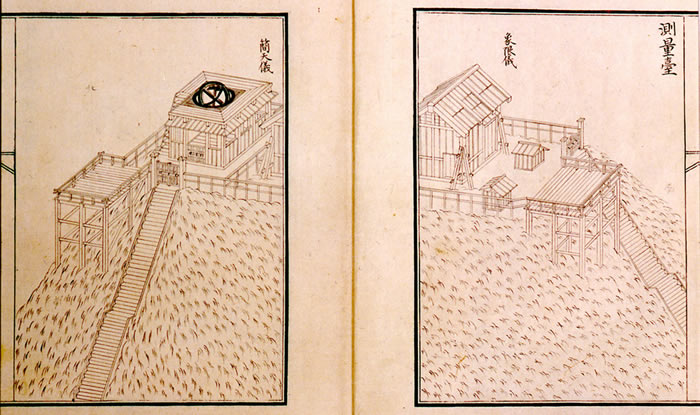Observatory Dome (Treatise on the Kansei Calendar)
Historical illustration・

| First Publication | 1844 (First year of the Kouka Era) |
|---|---|
| Author/illustrator | Kagesuke Shibukawa |
| Credit | Collection of the National Astronomical Observatory of Japan |
Historical illustration・

| First Publication | 1844 (First year of the Kouka Era) |
|---|---|
| Author/illustrator | Kagesuke Shibukawa |
| Credit | Collection of the National Astronomical Observatory of Japan |
This picture of the Observatory Dome is from the Treatise on the Kansei Calendar.
After the first independent Japanese calendar, the Jokyo Calendar, was made a calendar known as the Horyaku Calendar was adopted. But because the Horyaku Calendar was worse than the Jokyo Calendar, the Bakufu (the Shogun led military government) dispatched Yoshitoki Takahashi and Shigetomi Hazama to create the Kansei Calendar. The Kansei Calendar was the first to incorporate Western Astronomy. The observational equipment also made use of multiple Western techniques.
The details are collected in the Treatise on the Kansei Calendar, edited by Yoshitoki Takahashi’s second son, Kagesuke Shibukawa. The intricate diagrams and explanations printed there include this picture of the Observatory Dome.
The pictured Observatory Dome was placed in Asakusa in 1782 (2nd year of the Tenmen Era) so it was called the Astronomical Observatory in Asakusa. Until that time observatories would only be used temporarily until the new calendar was completed. In contrast, the Astronomical Observatory in Asakusa was a permanent observatory. It was used to establish the Kansei Calendar, and was called Hanrekishogoyouyajiki (Observatory for the Calendar) but even after the Kansei calendar was finished, observations continued until the end of the Edo Era.
With the Meiji Restoration, the office of Tenmonkata (Official Astronomer) was abolished and in 1869 (2nd year of the Meiji Era) the Astronomical Observatory in Asakusa was closed. The equipment used at the Astronomical Observatory in Asakusa was taken to Kaisei University; what happened to the equipment after that is unknown.
(Translator's Note: In addition to the standard Gregorian Calendar, Japan continues to use a reign era calendar. The different eras are defined by changes in the Japanese government, and accompanied by changes in Japanese society.)